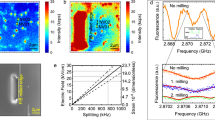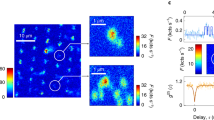Abstract
Nitrogen-vacancy colour centres in diamond can undergo strong, spin-sensitive optical transitions under ambient conditions, which makes them attractive for applications in quantum optics1, nanoscale magnetometry2,3 and biolabelling4. Although nitrogen-vacancy centres have been observed in aggregated detonation nanodiamonds5 and milled nanodiamonds6, they have not been observed in very small isolated nanodiamonds7. Here, we report the first direct observation of nitrogen-vacancy centres in discrete 5-nm nanodiamonds at room temperature, including evidence for intermittency in the luminescence (blinking) from the nanodiamonds. We also show that it is possible to control this blinking by modifying the surface of the nanodiamonds.
This is a preview of subscription content, access via your institution
Access options
Subscribe to this journal
Receive 12 print issues and online access
$259.00 per year
only $21.58 per issue
Buy this article
- Purchase on Springer Link
- Instant access to full article PDF
Prices may be subject to local taxes which are calculated during checkout




Similar content being viewed by others
References
Kurtsiefer, C., Mayer, S., Zarda, P. & Weinfurter, H. Stable solid-state source of single photons. Phys. Rev. Lett. 85, 290–293 (2000).
Balasubramanian, G. et al. Nanoscale imaging magnetometry with diamond spins under ambient conditions. Nature 455, 648–651 (2008).
Maze, J. R. et al. Nanoscale magnetic sensing with an individual electronic spin in diamond. Nature 455, 644–647 (2008).
Chang, Y.-R. et al. Mass production and dynamic imaging of fluorescent nanodiamonds. Nature Nanotech. 3, 284–288 (2008).
Smith, B. R. et al. Five-nanometer diamond with luminescent nitrogen-vacancy defect centers. Small 5, 1649–1653 (2009).
Tisler, J. et al. Fluorescence and spin properties of defects in single digit nanodiamonds. ACS Nano 3, 1959–1965 (2009).
Barnard, A. S. & Sternberg, M. Substitutional nitrogen in nanodiamond and bucky-diamond particles. J. Phys. Chem. B 109, 17107–17112 (2005).
Kruger, A. et al. Unusually tight aggregation in detonation nanodiamond: identification and disintegration. Carbon 43, 1722–1730 (2005).
Mochalin, V. N. & Gogotsi, Y. Wet chemistry route to hydrophobic blue fluorescent nanodiamond. J. Am. Chem. Soc. 131, 4594–4595 (2009).
Holt, K. B. Diamond at the nanoscale: applications of diamond nanoparticles from cellular biomarkers to quantum computing. Phil. Trans. R. Soc. A 365, 2845–2861 (2007).
Bradac, C., Gaebel, T., Naidoo, N., Rabeau, J. R. & Barnard, A. S. Prediction and measurement of the size-dependent stability of fluorescence in diamond over the entire nanoscale. Nano Lett. 9, 3555–3564 (2009).
Rabeau, J. R. et al. Single nitrogen vacancy centers in chemical vapor deposited diamond nanocrystals. Nano Lett. 7, 3433–3437 (2007).
Vlasov, I. et al. Nitrogen and luminsecent nitrogen-vacancy defects in detonation nanodiamond. Small 6, 687–694 (2010).
Boudou, J. P. et al. High yield fabrication of fluorescent nanodiamonds. Nanotechnology 20, 235602 (2009).
Smith, B. R., Gruber, D. & Plakhotnik, T. The effects of surface oxidation on luminescence of nano diamonds. Diamond Relat. Mater. 19, 314–318 (2010).
Gaebel, T. et al. Photochromism in single nitrogen-vacancy defect in diamond. Appl. Phys. B 82, 243–246 (2006).
Kuno, M., Fromm, D. P., Hamann, H. F., Gallagher, A. & Nesbitt, D. J. ‘On’/‘off’ fluorescence intermittency of single semiconductor quantum dots. J. Chem. Phys. 115, 1028–1040 (2001).
Tang, J. & Marcus, R. A. Diffusion-controlled electron transfer processes and power-law statistics of fluorescence intermittency of nanoparticles. Phys. Rev. Lett. 95, 107401 (2005).
Stefani, F. D., Hoogenboom, J. P. & Barkai, E. Beyond quantum jumps: blinking nanoscale light emitters. Phys. Today 34–39 (February 2009).
Nirmal, M. et al. Fluorescence intermittency in single cadmium selenide nanocrystals. Nature 383, 802–804 (1996).
Hoogenboom, J. P., van Dijk, E., Hernando, J., van Hulst, N. F. & Garcia-Parajo, M. F. Power-law-distributed dark states are the main pathway for photobleaching of single organic molecules. Phys. Rev. Lett. 95, 097401 (2005).
Mason, M. D., Credo, G. M., Weston, K. D. & Buratto, S. K. Luminescence of individual porous Si chromophores. Phys. Rev. Lett. 80, 5405–5408 (1998).
Cichos, F., von Borczyskowski, C. & Orrit, M. Power-law intermittency of single emitters. Curr. Opin. Colloid Interface Sci. 12, 272–284 (2007).
Frantsuzov, P., Kuno, M., Janko, B. & Marcus, R. A. Universal emission intermittency in quantum dots, nanorods and nanowires. Nature Phys. 4, 519–522 (2008).
Gomez, D. E., van Embden, J., Mulvaney, P., Fernee, M. J. & Rubinsztein-Dunlop, H. Exciton–trion transitions in single CdSe–CdS core–shell nanocrystals. ACS Nano 3, 2281–2287 (2009).
Zhang, K., Chang, H. Y., Fu, A. H., Alivisatos, A. P. & Yang, H. Continuous distribution of emission states from single CdSe/ZnS quantum dots. Nano Lett. 6, 843–847 (2006).
Palosz, B. et al. Investigation of relaxation of nanodiamond surface in real and reciprocal spaces. Diamond Relat. Mater. 15, 1813–1817 (2006).
Osswald, S., Yushin, G., Mochalin, V., Kucheyev, S. O. & Gogotsi, Y. Control of sp(2)/sp(3) carbon ratio and surface chemistry of nanodiamond powders by selective oxidation in air. J. Am. Chem. Soc. 128, 11635–11642 (2006).
Iakoubovskii, K. et al. Structure and defects of detonation synthesis nanodiamond. Diamond Relat. Mater. 9, 861–865 (2000).
Russo, S. P., Barnard, A. S. & Snook, I. K. Hydrogenation of nanodiamond surfaces: structure and effects on crystalline stability. Surf. Rev. Lett. 10, 233–239 (2003).
Morita, Y. et al. A facile and scalable process for size-controllable separation of nanodiamond particles as small as 4 nm. Small 4, 2154–2157 (2008).
Ushizawa, K. et al. Covalent immobilization of DNA on diamond and its verification by diffuse reflectance infrared spectroscopy. Chem. Phys. Lett. 351, 105–108 (2002).
Gruber, A. et al. Scanning confocal optical microscopy and magnetic resonance on single defect centers. Science 276, 2012–2014 (1997).
Porezag, D., Frauenheim, T., Kohler, T., Seifert, G. & Kaschner, R. Construction of tight-binding-like potentials on the basis of density-functional theory—application to carbon. Phys. Rev. B 51, 12947–12957 (1995).
Barnard, A. S. & Sternberg, M. Crystallinity and surface electrostatics of diamond nanocrystals. J. Mater. Chem. 17, 4811–4819 (2007).
Acknowledgements
The authors would like to thank N. Manson and F. Treussart for useful discussions, D. Birch for TEM measurements and E. Carter for Raman spectroscopy measurements. T.G. is funded by a Macquarie University Research Fellowship, C.B. is funded by a Macquarie University Research Excellence Scholarship, and J.R.R is funded by an ARC Future Fellowship. The work was funded in part by the Australian Research Council (DP0772286 and DP0771676).
Author information
Authors and Affiliations
Contributions
C.B., T.G., A.V.Z. and J.R.R. conceived and designed the experiments, analysed the data, contributed materials/analysis tools and co-wrote the paper. T.P. analysed the data and contributed analysis tools. M.J.S. contributed ESR equipment and expertise. A.S.B. carried out DFTB simulations and analysed simulation data. N.N., J.T., L.B. and J.R.R. designed the deaggregation protocol. N.N. prepared the nanodiamond samples. All authors discussed the results and commented on the manuscript.
Corresponding authors
Ethics declarations
Competing interests
The authors declare no competing financial interests.
Supplementary information
Supplementary information
Supplementary information (PDF 2830 kb)
Rights and permissions
About this article
Cite this article
Bradac, C., Gaebel, T., Naidoo, N. et al. Observation and control of blinking nitrogen-vacancy centres in discrete nanodiamonds. Nature Nanotech 5, 345–349 (2010). https://doi.org/10.1038/nnano.2010.56
Received:
Accepted:
Published:
Issue Date:
DOI: https://doi.org/10.1038/nnano.2010.56
This article is cited by
-
Effect of heat treatment on fluorescence characteristics of HPHT and detonation nanodiamonds
Applied Nanoscience (2022)
-
Single-particle spectroscopy for functional nanomaterials
Nature (2020)
-
Photoluminescence from NV− Centres in 5 nm Detonation Nanodiamonds: Identification and High Sensitivity to Magnetic Field
Nanoscale Research Letters (2019)
-
Quantum nanophotonics with group IV defects in diamond
Nature Communications (2019)
-
Fluorescent Fe Embedded Magnetic Nanodiamonds Made by Ion Implantation
Scientific Reports (2019)



